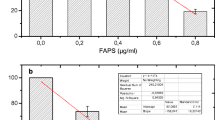Abstract
Malassezia is a facultative or obligatory lipophilic yeast. We devised new lipid-supplemented media suitable for the culture ofMalassezia. Malassezia furfur andM. pachydermatis grew well on both solid and liquid media supplemented with creaming powder preparations which are commercially available at moderate prices. Striking differences were found between the cellular fatty acid compositions ofM. furfur grown on media supplemented with creaming powder and that grown on media with conventional olive oil.Malassezia furfur grown on media with olive oil had nearly the same fatty acid composition as olive oil, with C18:1 amounting to 80%, while that grown on media supplemented with creaming powder had C16, C18:1 and C18:2 as the principal components. The use of these supplementary lipids appeared not to inhibit the normal synthesis of fatty acid inM. furfur. For the culture ofM. pachydermatis, media supplemented with creaming powder were also found more suitable than lipid-free media. The media devised are considered excellent, because they appear to provide a more natural growth environment forMalassezia.
Similar content being viewed by others
Literature cited
Jan Faergemann, M. D. 1985. Lipophilic yeasts in skin disease. Semin. Dermatol.4: 173–184.
Johanson, R. 1953. New specific reagent for keto-sugars. Nature21: 956–957.
Michael Dorn, M. D. and Roehnert, K. 1977. Dimorphism ofPityrosporum orbiculare in a defined culture medium. J. Invest. Dermatol.69: 244–248.
Morris, D. L. 1948. Quantitative determination of carbohydrates with Dreywood's anthrone reagent. Science107: 254–255.
Simmons, R. B. and Gueho, E. 1990. A new species ofMalassezia. Mycol. Res.94: 1146–1149.
Takahashi, M., Ushijima, T. and Ozaki, Y. 1981. Comparative studies on biochemical and serological characteristics of each species ofPityrosporum. Jpn. J. Med. Mycol.22: 314–321.
Uchida, K. and Yamaguchi, H. 1991. In vitro anti-Malassezia activity of terbinafine. Jpn. J. Med. Mycol.32: 343–346.
Ushijima, T., Takahashi, M. and Ozaki, Y. 1981. Selective and differential media for isolation and tentative identification of each species ofPityrosporum residing on normal or diseased human skin. Microbiol. Immunol.25: 1109–1118.
Author information
Authors and Affiliations
About this article
Cite this article
Nishikawa, H., Hara, N., Kosugi, C. et al. Suitability of lipid materials for culture ofMalassezia as evaluated from its cellular fatty acid composition. Mycoscience 38, 155–161 (1997). https://doi.org/10.1007/BF02460851
Accepted:
Issue Date:
DOI: https://doi.org/10.1007/BF02460851




